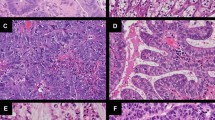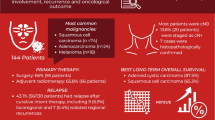Abstract
Sinonasal malignant neoplasms are rare and adenocarcinomas account for 10–20 % of these cancers. Our aim is to characterise the clinical presentation, risk factors and outcomes of patients with adenocarcinoma treated at our institution. Retrospective review of medical records of patients with sinonasal adenocarcinomas, treated at IPO-Porto from January 2008 until December 2012. Twenty-eight patients with adenocarcinomas were selected from a total of 53 patients with sinonasal cancers. There was a male predominance (93 %), a mean age at diagnosis of 56 years and a rate of occupational wood dust exposure of 71 %. The most common treatment option was surgery followed by adjuvant radiotherapy. The 5 year disease-free and cancer-specific survival was 58 and 60 %, respectively. The following factors had negative impact on disease-free survival: advanced AJCC stage (p = 0.014); skull base invasion (p = 0.002); poorly differentiated or mucinous subtypes histology (p = 0.034) and imaging findings of residual tumour before adjuvant radiotherapy (p < 0.001). Endoscopic tumour resection was not associated with adverse outcomes. The role of volume-modulated arch therapy in the treatment of sinonasal tumours has to be clarified. The higher rate of adenocarcinomas among sinonasal cancers in this series comparing with previous reports, even from our institution, suggests that this pathology is rising in Northern Portugal. Despite substantial local failure, sinonasal adenocarcinomas have a relatively favourable prognosis in terms of cancer-specific survival.





Similar content being viewed by others
References
Turner J, Reh D (2012) Incidence and survival in patients with sinonasal cancer: a historical analysis of population-base data. Head Neck 34:877–885
Bhayani MK, Yilmaz T, Sweeney A et al (2014) Sinonasal adenocarcinoma: a 16-year experience at a single institution. Head Neck. doi:10.1002/hed.23485
Barnes L (1986) Intestinal-type adenocarcinoma of the nasal cavity and paranasal sinuses. Am J Surg Pathol 10:192–202
Lund VJ, Stammberger H, Nikolai P et al (2010) European position paper on endoscopic management of tumours of the nose, paranasal sinuses and skull base. Rhinol Suppl 1(22):1–143
Barnes L, Eveson JW, Reichart P, Sidransky D (2005) Pathology and genetic: head and neck tumours. WHO classification of tumours. IARC press, Lyon cedex
Bernardo T, Ferreira E, Castro Silva J, Monteiro E (2013) Sinonasal adenocarcinoma—experience of an oncology center. Int J Otolaryngol Head Neck Cancer 2:13–16. doi:10.4236/ijohns.2013.21005
Acheson ED, Hadfield EH, Macbeth RG (1967) Carcinoma of the nasal cavity and accessory sinus in woodworkers. Lancet 1:311–312
Breheret R, Laccourreye L, Jeufroy C, Bizon A (2011) Adenocarcinoma of the ethmoid sinus: retrospective study of 42 cases. Eur Ann Otorhinolaryngol Head Neck Dis 128(5):211–217
Orvidas LJ, Lewis JE, Weaver AL et al (2005) Adenocarcinoma of the nose and paranasal sinuses: a retrospective study of diagnosis, histologic characteristics, and outcomes in 24 patients. Head Neck 27(5):370–375
Gabory L, Maunoury A, Maurice-Tison S et al (2010) Long-term single-center results of management of ethmoid adenocarcinoma: 95 patients over 28 years. Ann Surg Oncol 17(4):1127–1134
McMonagle BA, Gleeson M (2008) Nasal cavity and paranasal sinus maligancy. In: Scott-Brown MG (ed) Otolaryngology, head and neck surgery, 7th edn. Edward Arnold Publishers, London, pp 2417–2436
Choi HR, Sturgis EM, Rashid A et al (2003) Sinonasal adenocarcinoma: evidence for histogenetic divergence of the enteric and nonenteric phenotypes. Human Pathol 34(11):1101–1107
Franchi A, Gallo O, Santucci M (1999) Clinical relevance of the histological classification of sinonasal intestinal-type adenocarcinomas. Hum Pathol 30(10):1140–1145
Leivo I (2007) Update on sinonasal adenocarcinoma: classification and advances in immunophenotype and molecular genetic make-up. Head Neck Pathol 1(1):38–43
Jardeleza C, Seiberling K, Floreani S, Wormald PJ (2009) Surgical outcomes of endoscopic management of adenocarcinoma of the sinonasal cavity. Rhinology 47(4):354–361
Nicolai P, Villaret AB, Bottazzoli M et al (2011) Ethmoid adenocarcinoma–from craniofacial to endoscopic resections: a single-institution experience over 25 years. Otolaryngol Head Neck Surg 145(2):330–337
Gomez-Millan J, Jerez Sainz I, Perez Rozos A et al (2014) Potential advantages of volumetric arc therapy (VMAT) in head and neck cancer. Head Neck. doi:10.1002/hed.23685
Conflict of interest
No conflicts of interest to declare.
Author information
Authors and Affiliations
Corresponding author
Rights and permissions
About this article
Cite this article
Veloso-Teles, R., Ribeiro, I., Castro-Silva, J. et al. Adenocarcinomas of the sinonasal tract: a case series from an Oncology Centre in Northern Portugal. Eur Arch Otorhinolaryngol 272, 1913–1921 (2015). https://doi.org/10.1007/s00405-014-3265-2
Received:
Accepted:
Published:
Issue Date:
DOI: https://doi.org/10.1007/s00405-014-3265-2




